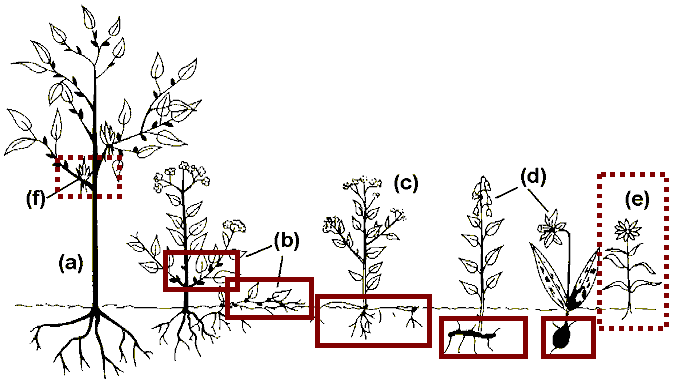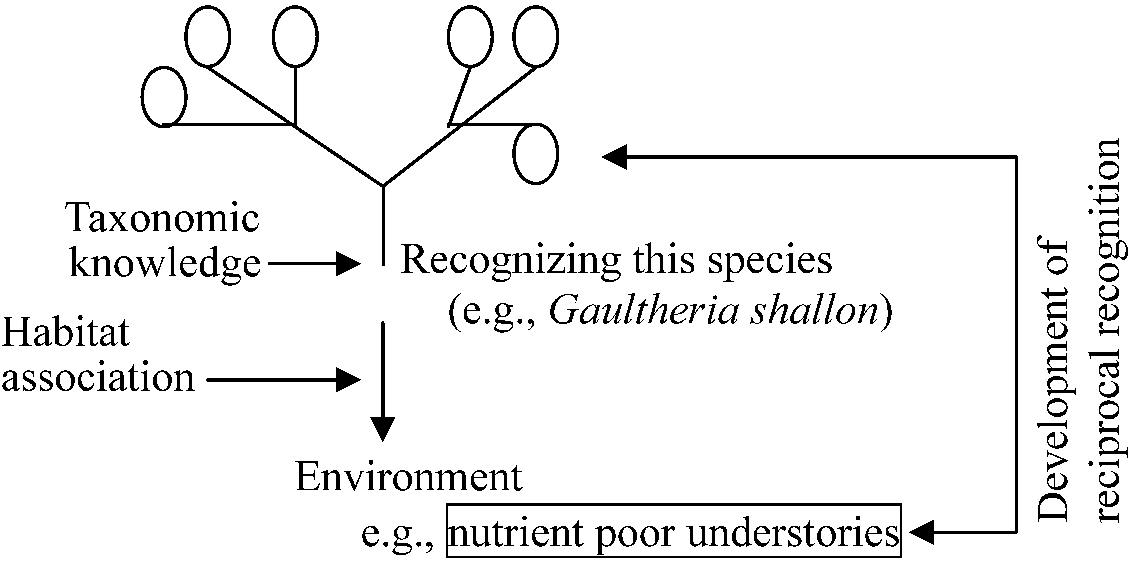(Upload on October 25 2024) [ 日本語 | English ]
Mount Usu / Sarobetsu post-mined peatland
From left: Crater basin in 1986 and 2006. Cottongrass / Daylily
HOME > Lecture catalog / Research summary > Glossary > Lifeform
|
Definition Raunkiaer's life form Raunkiaer's life form spectrum in the world Raunkiaer, Christen Christensen Bud dormancy and lifeform Indicator species Ecological characteristics (生態的形質)Certain aspects of growth forms represent a set of adaptation evolved in response to key evolutionary pressuresMode of life and species attributes
|
Spelling: life form, life-form or lifeform |
Evolution of lifeform through nutrient aquisition Maximizing the good times (良好タイミング最大化) (Boysen-Jensen 1937, Monsi 1960, Walter 1973, Schulze 1982)
The performance of a specific life span is measured by the marginal return of carbon per unit resource invested. |
Plant form adaptations to adjust this ratio
Wetland plantshydrophyte (水生植物) = aquatic plantshygrophyte (湿生植物/水生植物) = between hydorphytes and mesophytes, not developing special organs for water conditions halophyte (塩生植物): tolerant to salts mesophytes (中生植物): most plants xerophyte (乾生植物): adapted to uniform dryness or periodic dryness Ex. mangrove |
|
Species classified into a few life forms based on the place of the dormant organs during adverse seasons, i.e., cold and/or dry seasons Table. Raunkiaer's life form or dormancy form spectra (Raunkiaer 1934)
Sclerophyte (硬葉植物): a evergreen and xerophytic plant with thick, hard leaves  |
Fig. Raunkiaer's life form. Brown squares indicate the positions of dormant buds. (a) phanerophytes, (b) nanophanerophytes - chamaephytes, (c) hemicryptophytes, (d) geophytes, (e) therophytes, (f) epiphytes
Raunkiaer's life form spectrumTable 4. Selected Raunkiaerian life-form spectra for certain major climate. n: number of species examined. (Cain 1950)
Vegetation type climate and locality
n
Ph
Ch
H
G/HH
Th
|
| Species | Depth of bud dormancy |
Type of dormancy |
Type of dormant bud |
Raunkiaer's lifeform |
Phenology of shoot |
||
| Oct. | Dec. | ||||||
| 1. | Erigeron annuus | 3 | 4 | I | A | Hpr | WG-SG |
| 2 | Oenothera biennis | 3 | 6 | I | A | Hpr | WG-SG |
| 3 | Geum aleppicum | 6 | 7 | I | A | Hpr | EG |
| 4 | Rumex acetosella | 3 | 4 | I | A | Hpr | SG |
| 5 | Viola sp. | 6 | 7 | I | A | Hr | SG |
| 6 | Trifolium repens | 5 | 5 | I | A | H | SG |
| 7 | Plantago lanceolata | 6 | 6 | I | A | Hr | EG |
| 8 | Plantago asiatica | 23 | 4 | II | B | Hr | SG |
| 9 | Leibnitzia anandria | 54 | 11 | II | B | Hr | Sg |
| 10 | Solidago virga-aurea | 39 | 12 | II | B | protH | SG |
| 11 | Aster sp. | 19 | 19 | II | Bb | protH | SG |
| 12 | Solidago altissima | 45 | 18 | II | Bb | protH | SG |
| 13 | Artemisia japonica | 37 | 8 | II | B | protH | SG |
| 14 | Artemisia montana | 54 | 10 | II | B | protH | SG |
| 15 | Anaphalis margaritacea var. angustior | 39 | 17 | II | B | protH | SG |
| 16 | Sanguisorba tenuifolia var. tenuifolia f. alba | 52 | 15 | II | B | protH | SG |
| 17 | Tiarella polyphylla | 19 | 10 | II | C | Ch | EG |
| 18 | Pyrola incarnata | 59 | 16 | II | Cc | Ch | EG |
| 19 | Pachysandra terminalis | 25 | 11 | II | Cc | Ch | EG |
| 20 | Agrimonia japonica | 23 | 7 | II | Bb | Grh | SG |
| 21 | Geranium thunbergii | 17 | 13 | II | C | Grh | SG |
| 22 | Filipendula camtschatica | (300) | 11 | III | B | Grh | SG |
| 23 | Helianthus tuberosus | 300 | 33 | III | B | Gst | SG |
| 24 | Aster glehnii | 300 | 240 | III | B | Grh | SG |
| 25 | Adenocaulon himalaicum | 300 | 60 | III | B | Grh | SG |
| 26 | Cacalia hastata var. orientalis | 300 | 24 | III | B | Grh | SG |
| 27 | Polygonum filiforme | 300 | 31 | III | B | Grh | SG |
| 28 | Phrma leptostachya var. asiatica | 300 | 23 | III | B-C | Grh | SG |
| 29 | Cacalia delphiniifolia | 300 | 19 | III | B-C | Grh | SG |
| 30 | Cacalia auriculata var. kamtschatica | 300 | 16 | III | B-C | Grh | SG |
| 31 | Diphylleia grayi | 300 | 43 | III | C | Grh | SG |
| 32 | Petasites japonicus var.giganteus | (300) | 8 | III | C | Grh | SG |
| 33 | Lilium cordatum var. glehnii | 300 | 53 | III | C | Gbulb | SG |
| 34 | Trillium smallii | 300 | 46 | III | Cc | Grh | SG |
| 35 | Trillium tschonskii | 300 | 50 | III | Cc | Grh | SG |
| 36 | Trillium kamtschaticum | 300 | 41 | III | Cc | Grh | SG |
| 37 | Paris tetraphylla | 300 | 25 | III | Cc | Grh | SG |
| 38 | Chloranthus japonicus | 300 | 33 | III | Cc | Grh | SG |
| 39 | Erythronium japonicum | 300 | 60 | III | Cc | Gbulb | SPG |
| 40 | Gagea lutea | 300 | 24 | III | Cc | Gbulb | SPG |
| 41 | Anemone raddeana var. integra | 300 | 31 | III | C | Grh | SPG |
| 42 | Panax japonicus | 300 | 28 | III | C | Grh | SG |
| 43 | Maianthemum dilatatum | (300) | 10 | III | Cc | Grh | SG |
*: 300 and 240 - No bud burst within 300 days and 240 days, respectively.
*: (300) - A few buds burst within 300 days.
Bb: Some buds had swollen or burst slightly in late October.
Cc: Shoot which develop in the following vegetative period are performed in the dormant bud.
*: Hpr - Partial rosette plant of hemicryptophytes, Hr - Rosette plant of hemicryptophytes, protoH - protohemicryptophyte, Ch - Chamaephyte, Grh - Rhizome geophyte, Gst - Stem-tuber geophyte, and Gbulb-Bulb geophyte.
++: WC - Wintergreen, SC - Summergreen, EG-Evergreen, SPC-Springgreen.
Species that indicates the characteristics of the environmental conditions, such as serpentine.
Bioindicator≈ biomonitorPlant, animal or chemicals used to monitor an environment and/or ecosystem Biomonitoringthe measurement of the body burden of toxic chemical compounds, elements, or their metabolites, in biological substancesMethods and procedures on determining indicator species |
literature, asking |
|
Plant species used as indicator species. Plants can not move greatly except when they are seeds (and pollens). Therefore, each plant establishes in a respective soil type, topography and climate, and generally indicates the environments better than animals.
Phragmites australis - indicates wet habitat Environmental factorspH, nutrients, moisture, light, temperature, salinity, etc.+ disturbance (grazing, fire frequency and intensity, flood) → assumption: the past environment s could be estimated based on the established plants + successional status Site potentialHistorical conditionLife form and biotic indicatorsindividual speciesmorphological patterns
plasticity (Grime 1973) |
Quiz
(Bartelheimer & Poschlod 2016) Ellenberg indicator valuecan be used as a numerical system to classify species habitat niches and their peak occurrence along gradientsThe picture emerging is that multiple determinants can be identified for: N (nitrogen/nutrients) 1 = only growing on the poorest soils → 9 = only growing on excessively nitrogen (nutrient)-rich soils R (soil reaction numbers)1 = strong acidity (never moderately acidic or alkaline) → 9 = alkaline and calcareous conditions, only calcareous soils M (soil moisture numbers): 1-12
1 = species only on dry soils → 9 = only on wet or hypoxic soils 1 = deep shadow with 1–30% of full light available → 9 = only growing in full light to minimum 50% of full light C (continentality)the distance to the sea in Central Europe, where 'eucontinental' (C = 9) represents a species peak distribution at a far distance to the sea and 'euoceanic' (C = 1) indicates close proximity to the sea T (tmperature numbers)predominantly relate to species occurrence at respective elevations above sea level (lower T) correspond to higher elevations) but additionally include planar/especially warm habitats in Europe Proably this indicator value can not be applied to Japan. |